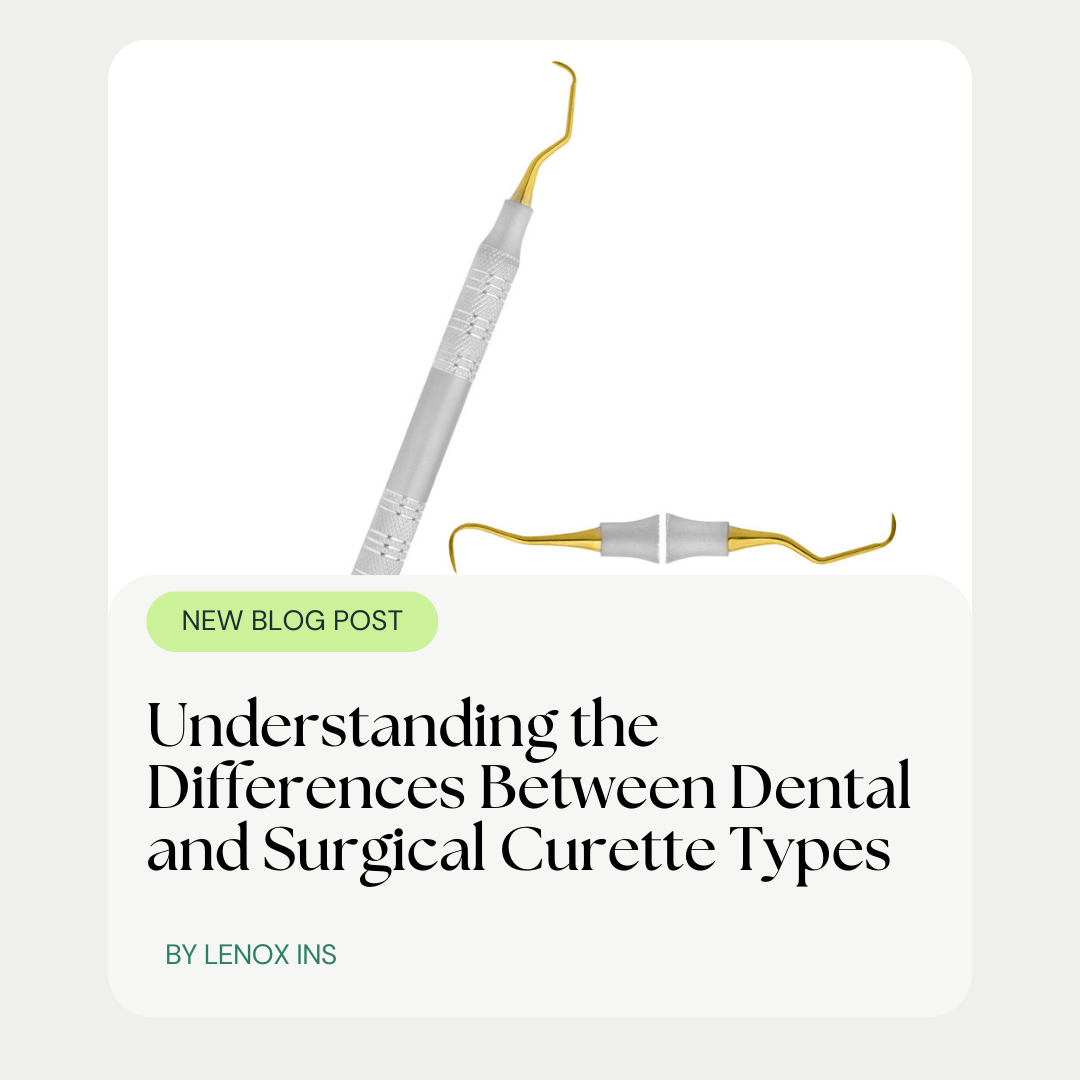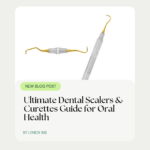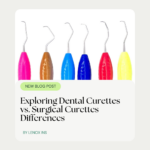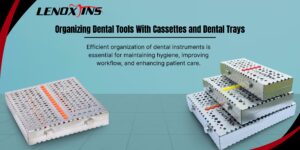Understanding the Differences Between Dental and Surgical Curette Types
- lenoxinstro
- November 25, 2024
- Dental Instruments

Are you unsure about the differences between dental and surgical curettes? This is a common challenge many dental professionals face. In this article, I’ll clarify the various types of curettes used in both dental and surgical settings, detailing their distinct features and functions. By understanding these differences, you’ll be equipped to select the right tools for your practice, enhancing patient care and improving procedural outcomes. I will address how this knowledge can help you make informed decisions that ultimately lead to better treatment results, whether you’re dealing with oral health or related surgical procedures involving veins or tissues.
Understanding Curettes in Medical Practice

A curette is a versatile instrument used in both dental and surgical procedures for scraping, cleaning, or removing tissue. In healthcare, curettes play a critical role in various applications, such as radiology and stem cell collection, ensuring effective irrigation and minimizing the risk of infection. Understanding the specific requirements and measurement techniques for dental versus surgical curettes helps enhance outcomes in clinical practices.
What Is a Curette and How Is It Used?
A curette is a crucial tool in both dental and surgical settings, designed specifically for scraping and tissue removal. In dental practices, I often rely on curettes for procedures involving tooth and gum maintenance, where precise tissue management is necessary. In surgery, the application may include using a curette in conjunction with tools like a laser or retractor for more delicate operations, ensuring thorough cleaning and minimizing the risk of infection within confined areas such as the rectum or other anatomical sites:
- Curettes vary in design to meet specific procedural needs.
- They are essential for both scraping and tissue removal in dental and surgical environments.
- Understanding the proper use of a curette can enhance patient outcomes.
The Role of Curettes in Health Care
Curettes are indispensable tools in healthcare, serving a variety of roles that enhance therapeutic outcomes. In my experience, during procedures that require precise tissue management, such as joint therapies, I often utilize curettes alongside instruments like hegar dilators and hemostats to ensure thorough cleaning and effective saline irrigation. This combination not only promotes better healing but also significantly reduces the risk of complications, supporting overall patient safety and satisfaction.
Importance of Curettes in Dental and Surgical Procedures
Curettes play a vital role in both dental and surgical procedures, directly impacting patient outcomes. In my practice, I find that the correct selection of a curette, including considerations of length and design, significantly enhances the effectiveness of procedures. For instance, using a Davis curette in the mouth allows for precise tissue removal and ensures that the instrument can be effectively sterilized in an autoclave for maximum hygiene. Understanding these details can help professionals optimize their trays and improve overall procedural efficiency.
Exploring Dental Curette Types

In this section, I will discuss the different types of dental curettes and their applications in oral care. I’ll delve into how these specialized instruments are designed to address specific dental diseases, including features that enhance their performance, such as the tenaculum for improved grip. Additionally, I’ll cover the materials commonly used in dental curettes, ensuring their durability and effectiveness during in vivo procedures while minimizing the pressure needed for tissue management.
Different Types of Dental Curettes
In my experience, dental curettes come in various types, each designed with specific angles and features to address different dental issues. For example, hand-held curettes with angled blades allow for precise scraping of calculus and debris from tooth surfaces, making them effective for periodontal treatment. Additionally, I have found that specialized instruments, such as those used in microsurgery, often incorporate carbon dioxide laser technology, enhancing their efficacy while minimizing tissue damage during delicate procedures.
How Dental Curettes Are Used in Oral Care
In my practice, dental curettes are essential for effectively managing oral health by facilitating precise tissue removal and cleaning. When using these instruments, I often focus on their design to ensure fluid dynamics are optimal during procedures, allowing for easier debris clearance. For example, when treating inflamed gums or calculus buildup, I utilize carbon steel curettes because their sharpness enables thorough scraping with minimal pressure, enhancing patient comfort and safety while avoiding complications like tissue damage.
Design Features Specific to Dental Curettes
Dental curettes feature distinct design elements that cater specifically to the nuances of oral care, enhancing their effectiveness in various procedures. Their ergonomic handles offer improved grip, which is essential during intricate tasks such as scraping calculus while considering occlusion pressures. I find that incorporating components like a flexible blade allows for maneuverability in tight spaces, making these instruments effectively serve in diverse clinical scenarios that include patient nursing during treatments and diagnostics supported by imaging techniques. Lucas bone curettes micro serrated 5mm
- Ergonomic handles for better grip during use.
- Flexible blades for maneuverability in tight oral spaces.
- Designed specifically to address occlusion pressures in dental procedures.
Materials Commonly Used in Dental Curettes
The materials used in dental curettes are crucial for their effectiveness and durability during procedures. I often choose stainless steel for its strength and corrosion resistance, ensuring a long-lasting instrument that maintains sharpness for precise scraping. In some instances, I incorporate plastic components in specific applications to reduce weight and enhance maneuverability, particularly in procedures involving delicate tissues or areas requiring anesthesia. Understanding these material differences helps optimize instrument selection and enhances patient outcomes during oral care treatments.
An Overview of Surgical Curette Varieties

In examining surgical curette varieties, I focus on several key aspects that enhance their effectiveness in medical procedures. I will discuss the different types of surgical curettes and their specific applications for removing soft tissue. Additionally, I’ll cover unique design elements that improve functionality during use, as well as the materials used in construction, which often incorporate disinfectant properties. Understanding these factors is essential for optimizing surgical outcomes. Gracey curettes
Various Types of Surgical Curettes
In my experience working with surgical curettes, I have come across several types specifically designed for various procedures. For example, metal curettes are often utilized in neurosurgery for their precise scraping capabilities, allowing for effective tissue removal from delicate areas, including the ear. Additionally, using surgical curettes with unique features tailored to specific procedures can enhance outcomes and reduce the risk of complications, making them an invaluable tool in my practice.
Applications of Curettes in Surgery
In surgical practice, curettes are invaluable for various applications, particularly in procedures that involve removing soft tissue, managing fistulas, and addressing pulp issues. My experience has shown that selecting the right surgical curette based on its design parameters can significantly impact the efficiency of the procedure. For example, I often choose specific curettes with wire handles for greater precision and control when navigating complex areas, ensuring effective removal while minimizing trauma to surrounding tissues.
- Utilization of surgical curettes for precise soft tissue removal.
- Importance of selecting the right curette based on procedure parameters.
- Application of wire-handled curettes for improved control in delicate areas.
Unique Design Elements of Surgical Curettes
In my experience, surgical curettes are designed with unique elements that enhance their functionality during delicate procedures. The handle often features ergonomic designs to provide better grip and control, especially when navigating challenging areas such as the removal of debris from an endometrial polyp. Additionally, the blades are crafted to allow for precise tissue management, enabling me to deliver the appropriate dose of force necessary to avoid damaging surrounding muscle tissue while ensuring effective excision.
Materials Used in Surgical Curette Construction
When selecting surgical curettes, the materials used in their construction play a vital role in their performance and longevity. In my experience, stainless steel is the most common choice due to its strength and resistance to corrosion, ensuring that the jaw remains sharp and effective over time. Additionally, I often encounter curettes with an ergonomic handle designed to accommodate various diameters, enhancing my grip and control during procedures that involve delicate pathology, such as the removal of lesions or debris surrounding an elevator during surgery, ultimately contributing to better patient outcomes. Gracey curettes
Key Differences Between Dental and Surgical Curettes

Understanding the key differences between dental and surgical curettes is essential for effective clinical practice. I will compare their designs and structures, highlighting how specialized features cater to unique functions in dentistry and surgery. Additionally, I will address material and manufacturing differences, focusing on the use of stainless steel, as well as variations in sterilization and maintenance practices that ensure optimal performance, including the handling of cannula and the use of finger scissors.
Comparing Designs and Structures
When I compare the designs and structures of dental and surgical curettes, distinct features become evident that cater to their respective functions. Dental curettes, often used in orthodontics, are meticulously crafted for accessing and cleaning around teeth, with angles that promote precise scraping of calculus and debris. In contrast, surgical curettes, utilized in procedures like bladder dissection, are designed for sturdiness and larger tissue removal, enabling effective management of soft tissue in more expansive surgical fields. These design variations highlight the specialized equipment required to address the unique demands of both dentistry and surgery:
- Dental curettes feature angled blades for tooth and gum care.
- Surgical curettes offer robust construction for soft tissue management.
- Design differences enhance effectiveness in their respective fields.
Distinct Functions in Dentistry vs. Surgery
In my experience, the distinct functions of dental and surgical curettes highlight their specific applications in practice. For dental procedures, I often use curettes primarily for removing calculus and debris from tooth surfaces, which is essential for maintaining oral health. In contrast, surgical curettes are utilized in various procedures such as biopsies and tissue removals, where precision is critical, often aided by ultrasound technology. Understanding these differences empowers professionals to select the right instruments for their tasks, ultimately enhancing patient outcomes during procedures like dental extractions or soft tissue management. dental surgical
Material and Manufacturing Differences
The material and manufacturing differences between dental and surgical curettes fundamentally influence their performance in clinical settings. Dental curettes are predominantly constructed from stainless steel, ensuring they maintain sharpness and durability during procedures involving the delicate removal of plaque and calculus. In contrast, surgical curettes may incorporate specialized materials designed for specific applications, such as those used in urology for managing cysts or during umbilical cord operations, where suction features may be necessary for effective tissue management. Understanding these distinctions helps healthcare providers select the most suitable instruments for achieving optimal results in both dental and surgical practices.
Differences in Sterilization and Maintenance Practices
The sterilization and maintenance practices for dental and surgical curettes differ significantly due to their distinct applications and required settings. In my experience, dental curettes typically undergo simpler cleaning protocols since their primary use involves soft tissues in the oral cavity, which may have a lower risk of contamination. Conversely, surgical curettes, especially those used in procedures involving the cervix or abdomen, demand rigorous sterilization processes to eliminate any potential pathogens, as they often encounter exposure to blood and other body fluids during procedures, such as nerve surgery or tissue excision. For effective sterilization, I follow these key practices: curettes periodontal
- Dental curettes are often autoclaved after cleaning to ensure they are free from any residual contaminants.
- Surgical curettes may require additional chemical disinfectants due to the potential exposure to harmful pathogens.
- Regular maintenance checks help ensure that both types of instruments remain functional and safe for use.
Selecting the Right Curette for Your Practice

Selecting the right curette for your practice involves several crucial factors. First, I assess the specific procedures you plan to perform, whether related to periodontology, a molar extraction, or even a hysterectomy. Understanding the nuances between dental and surgical curette types is vital, as this choice affects patient outcomes. I’ll also cover how to evaluate the quality and reliability of curettes, ensuring you choose instruments that meet your procedural needs effectively.
Factors to Consider When Choosing a Curette
When selecting a curette for your practice, several important factors come into play. First, consider the specific procedures you plan to perform, such as biopsies involving soft tissues like polyps or histology assessments that require precise tissue collection. Also, look at accompanying tools like Metzenbaum scissors and whether your procedures will utilize visualization aids such as an endoscope, which may require specialized curettes for adequate access and control during delicate dissection procedures.
| Factor | Description |
|---|---|
| Type of Procedure | Identify the specific procedures you will be performing, such as biopsy of polyps or histological sampling. |
| Instrumentation | Evaluate the need for additional instruments like Metzenbaum scissors for tissue management. |
| Visualization Tools | Consider using an endoscope for enhanced visibility during complex procedures. |
| Tissue Handling | Assess how the curette interacts with staining processes to ensure quality of tissue samples. |
Matching Curette Types to Specific Procedures
Matching curette types to specific procedures is critical in both dentistry and surgery. For instance, in endodontics, I find that using a designated Gracey curettes allows for precise cleaning of the root canal system, thus enhancing the chances of successful diagnosis and treatment outcomes. On the surgical side, when performing procedures such as biopsies or soft tissue excisions, selecting the right surgical instrument ensures that I adhere to ethical standards while minimizing the risk of complications, ultimately supporting the statistical significance of patient safety and satisfaction.
Evaluating Quality and Reliability in Curettes
When I evaluate the quality and reliability of curettes, I prioritize materials that enhance performance, such as tungsten carbide, known for maintaining sharpness and strength. This is especially crucial in areas like colorectal cancer surgeries, where precision is vital for effective tissue management. Additionally, understanding how instruments like the veress needle integrate into surgical workflows can improve efficiency and patient outcomes, ensuring that as a surgeon, I’m prepared for any specific procedural demands.
Best Practices for Care and Maintenance of Curettes

Proper handling techniques are crucial to maintaining the integrity of both dental and surgical curettes. I will provide guidelines for cleaning and sterilization tailored to minimize the risk of infection, particularly in procedures involving wound care or body cavities. Additionally, I’ll share tips for extending the lifespan of your curettes, ensuring they remain effective tools in managing periodontal disease and other clinical needs.
Proper Handling Techniques
Proper handling techniques for dental and surgical curettes are essential to ensure optimal performance and longevity. I prioritize maintaining a clear workspace and handling each instrument with care, as this minimizes the risk of contamination. After each use, I ensure thorough sterilization protocols are followed, including the use of the copyright clearance center for tracking sterilization processes, which helps maintain a safe environment for patient care.
Guidelines for Cleaning and Sterilization
To ensure the longevity and effectiveness of both dental and surgical curettes, I follow stringent cleaning and sterilization guidelines. After each use, I meticulously clean the instruments to remove any organic material, utilizing enzymatic cleaners that effectively break down blood and tissue residues. This initial cleaning step is crucial before autoclaving to achieve complete sterilization, as it significantly reduces the risk of cross-contamination and infection during procedures.
Tips for Extending the Lifespan of Your Curettes
To extend the lifespan of your curettes, I recommend implementing simple yet effective care practices. Regularly inspecting each instrument for signs of wear or damage can help you identify potential issues before they affect performance. Additionally, after every use, I ensure that cleaning protocols are strictly followed; this often includes using enzymatic cleaners to remove residues, followed by thorough sterilization in an autoclave. Simple actions like storing curettes in a protective case and using them only for their intended purposes can significantly enhance their durability:
| Care Practice | Description |
|---|---|
| Regular Inspection | Check for wear or damage to identify issues early. |
| Thorough Cleaning | Use enzymatic cleaners and autoclave for sterilization after each use. |
| Proper Storage | Keep curettes in a protective case when not in use. |
| Intended Use | Utilize curettes only for their specific intended procedures. |
Conclusion
Understanding the differences between dental and surgical curette types is crucial for optimizing clinical outcomes in both fields. Each type of curette is designed with specific features that enhance their effectiveness in managing oral health or performing delicate surgical procedures. By selecting the appropriate curette based on the intended application, practitioners can improve patient safety, reduce complications, and ensure successful treatment results. Staying informed about these distinctions empowers dental and medical professionals to make informed choices that ultimately benefit their patients and their practices.





